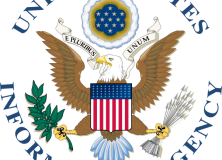The Crisis in U.S. Public Diplomacy: The Demise of USIA — Juliana Geran Pilon and Nicholas J. Cull

INTRODUCTION:
The transfer of the United States Information Agency (USIA) into the Department of State (DOS) reorganized U.S. public diplomacy in response to the end of the Cold War. Yet, nearly ten years later, the performance of American public diplomacy is much maligned and reform is again being debated, with presidential candidates and cabinet secretaries calling for change. An examination of the absorption of USIA by DOS therefore provides timely lessons for future interagency organization and public diplomacy strategy development. As such, this examination is important for the Project on National Security Reform (PNSR).
STRATEGY:
In 1995 Senator Jesse Helms initiated comprehensive reorganization of U.S. public diplomacy by introducing legislation which, among other measures, called for the consolidation of USIA into the State Department. In March 1997, the White House backed disestablishing USIA when Secretary of State Madeline Albright and Assistant Secretary of State James Rubin presented USIA Director Joe Duffey and his deputy, Penn Kemble, with a consolidation proposal which the Oval Office hoped to advance within sixty days. USIA leadership promptly registered objections with the content and timeline of the plan but in April, President Clinton introduced an initiative under which USIA and the Arms Control and Disarmament Agency (ACDA) would be consolidated into the State Department and the U.S. Agency for International Development (USAID) would no longer have budgetary independence from DOS. Under the subsequent authority of the Foreign Affairs Reform and Restructuring Act, which Congress passed and the President signed in 1998, USIA ceased operation as an independent agency in October 1999.
In hindsight, dissolving USIA was not coherent strategy. Public diplomacy practitioners were allowed limited input into the process and there seemed to have been limited exploration of the relevant factors and challenges involved in the absorption of USIA into the State Department. In addition, there was limited cost-benefit analysis of how the change might adversely influence the effectiveness of public diplomacy.
INTEGRATED ELEMENTS OF NATIONAL POWER:
Although USIA’s input was essentially set aside in the decision to move USIA into the State Department, the two organizations collaborated reasonably well in implementing the consolidation. In October 1999, USIA’s functions were divided within DOS between the Bureau of Educational and Cultural Affairs, the Bureau of International Information Programs, the Bureau of Intelligence and Research, and the Bureau of Public Affairs. Regional bureaus absorbed all USIA and United States Information Serves (USIS) field staff who became subject to the authority of the relevant Assistant Secretary of State. Though the structure appeared elegant on paper, it did not ensure effective cooperation. Creating unity of purpose proved particularly problematic as former USIA officials were well aware of traditional disdain for public diplomacy within Foggy Bottom.
EVALUATION:
The ill-advised reorganization resulted in part from a profound, long-standing inability of non-public diplomacy agencies to appreciate the significance of public diplomacy and allow USIA a seat at the table of policy formation. Within DOS, integration has been undermined by the distinct organizational cultures of DOS and USIA and by the imperfect authorities of the new public diplomacy structure. Charging the undersecretary with responsibility for public affairs and public diplomacy has further complicated strategic direction as the pressures of short-term public affairs inevitably trump longer-term public diplomacy activities. Finally, as ever, public diplomacy at DOS has suffered from staffing, training, and funding insufficiencies.
RESULTS:
U.S. public diplomacy in its new institutional home has not been able to effectively fight the war of ideas. In this context, the true costs of restructuring are perhaps best measured in historic public diplomacy deficiencies that were no addressed by restructuring. These include an absence of provisions to ensure interagency coordination; the lack of a USG-wide definition of “public diplomacy” itself; insufficient resourcing; inadequate roles for research and evaluation in communication outreach and for the private sector; obsolete regulations; and no unifying strategic framework for public diplomacy initiatives.
CONCLUSION:
An investigation of the reconstitution of USIA within DOS illustrates the tenacity of agency-specific cultures, the importance of institutional authorities, and the incidence of non-consultation in USG restructuring. Above all, however, the precipitous reorganization points to consistent undervaluation of the public diplomacy function within the U.S. national security system.